汽车专业英语课程总结 -
- 格式:doc
- 大小:29.50 KB
- 文档页数:2
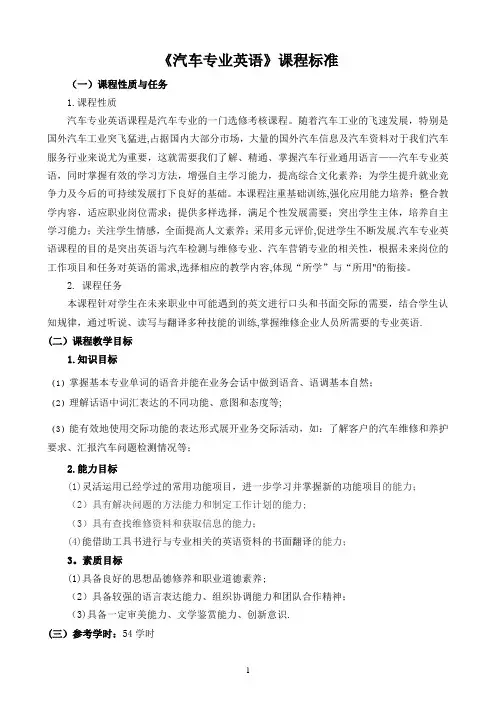
《汽车专业英语》课程标准(一)课程性质与任务1.课程性质汽车专业英语课程是汽车专业的一门选修考核课程。
随着汽车工业的飞速发展,特别是国外汽车工业突飞猛进,占据国内大部分市场,大量的国外汽车信息及汽车资料对于我们汽车服务行业来说尤为重要,这就需要我们了解、精通、掌握汽车行业通用语言——汽车专业英语,同时掌握有效的学习方法,增强自主学习能力,提高综合文化素养;为学生提升就业竞争力及今后的可持续发展打下良好的基础。
本课程注重基础训练,强化应用能力培养;整合教学内容,适应职业岗位需求;提供多样选择,满足个性发展需要;突出学生主体,培养自主学习能力;关注学生情感,全面提高人文素养;采用多元评价,促进学生不断发展.汽车专业英语课程的目的是突出英语与汽车检测与维修专业、汽车营销专业的相关性,根据未来岗位的工作项目和任务对英语的需求,选择相应的教学内容,体现“所学”与“所用"的衔接。
2. 课程任务本课程针对学生在未来职业中可能遇到的英文进行口头和书面交际的需要,结合学生认知规律,通过听说、读写与翻译多种技能的训练,掌握维修企业人员所需要的专业英语. (二)课程教学目标1.知识目标(1)掌握基本专业单词的语音并能在业务会话中做到语音、语调基本自然;(2)理解话语中词汇表达的不同功能、意图和态度等;(3)能有效地使用交际功能的表达形式展开业务交际活动,如:了解客户的汽车维修和养护要求、汇报汽车问题检测情况等;2.能力目标(1)灵活运用已经学过的常用功能项目,进一步学习并掌握新的功能项目的能力;(2)具有解决问题的方法能力和制定工作计划的能力;(3)具有查找维修资料和获取信息的能力;(4)能借助工具书进行与专业相关的英语资料的书面翻译的能力;3。
素质目标(1)具备良好的思想品德修养和职业道德素养;(2)具备较强的语言表达能力、组织协调能力和团队合作精神;(3)具备一定审美能力、文学鉴赏能力、创新意识.(三)参考学时:54学时(四)课程学分:3学分(五)课程内容及要求(六)实施建议1.教学方法课程教学方法与手段是以理实一体化教学为主体,能够根据课程内容和学生特点,灵活运用案例分析、分组讨论、角色扮演、启发引导等教学方法。
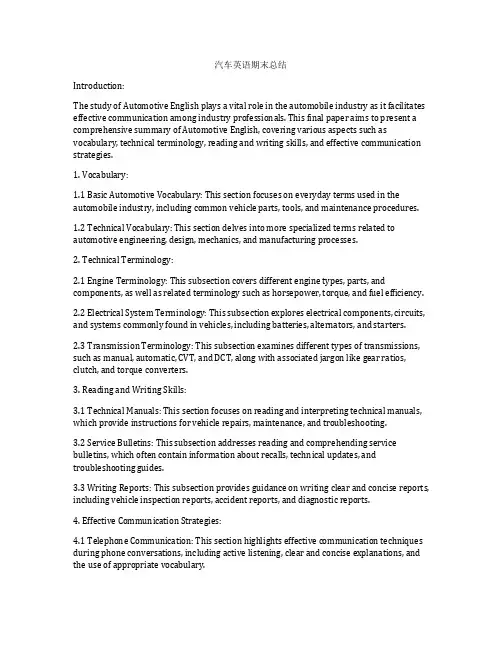
汽车英语期末总结Introduction:The study of Automotive English plays a vital role in the automobile industry as it facilitates effective communication among industry professionals. This final paper aims to present a comprehensive summary of Automotive English, covering various aspects such as vocabulary, technical terminology, reading and writing skills, and effective communication strategies.1. Vocabulary:1.1 Basic Automotive Vocabulary: This section focuses on everyday terms used in the automobile industry, including common vehicle parts, tools, and maintenance procedures.1.2 Technical Vocabulary: This section delves into more specialized terms related to automotive engineering, design, mechanics, and manufacturing processes.2. Technical Terminology:2.1 Engine Terminology: This subsection covers different engine types, parts, and components, as well as related terminology such as horsepower, torque, and fuel efficiency.2.2 Electrical System Terminology: This subsection explores electrical components, circuits, and systems commonly found in vehicles, including batteries, alternators, and starters.2.3 Transmission Terminology: This subsection examines different types of transmissions, such as manual, automatic, CVT, and DCT, along with associated jargon like gear ratios, clutch, and torque converters.3. Reading and Writing Skills:3.1 Technical Manuals: This section focuses on reading and interpreting technical manuals, which provide instructions for vehicle repairs, maintenance, and troubleshooting.3.2 Service Bulletins: This subsection addresses reading and comprehending service bulletins, which often contain information about recalls, technical updates, and troubleshooting guides.3.3 Writing Reports: This subsection provides guidance on writing clear and concise reports, including vehicle inspection reports, accident reports, and diagnostic reports.4. Effective Communication Strategies:4.1 Telephone Communication: This section highlights effective communication techniques during phone conversations, including active listening, clear and concise explanations, and the use of appropriate vocabulary.4.2 Customer Service Skills: This subsection emphasizes the importance of excellent customer service, including handling customer complaints, providing accurate information, and maintaining a professional and courteous demeanor.4.3 Negotiating Skills: This subsection explores negotiation strategies, such as persuasive communication, credibility, and compromise, to facilitate successful business agreements within the automotive industry.Conclusion:In conclusion, the study of Automotive English is crucial for effective communication in the automobile industry. This comprehensive summary has covered various aspects of Automotive English, including vocabulary, technical terminology, reading and writing skills, and effective communication strategies. By mastering these skills, automotive professionals will be better equipped to collaborate, innovate, and excel in their respective fields.。
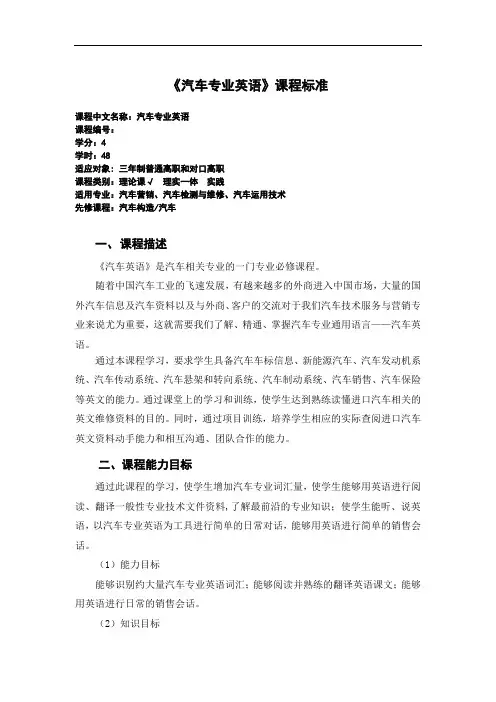
《汽车专业英语》课程标准课程中文名称:汽车专业英语课程编号:学分:4学时:48适应对象: 三年制普通高职和对口高职课程类别:理论课√理实一体实践适用专业:汽车营销、汽车检测与维修、汽车运用技术先修课程:汽车构造/汽车一、课程描述《汽车英语》是汽车相关专业的一门专业必修课程。
随着中国汽车工业的飞速发展,有越来越多的外商进入中国市场,大量的国外汽车信息及汽车资料以及与外商、客户的交流对于我们汽车技术服务与营销专业来说尤为重要,这就需要我们了解、精通、掌握汽车专业通用语言——汽车英语。
通过本课程学习,要求学生具备汽车车标信息、新能源汽车、汽车发动机系统、汽车传动系统、汽车悬架和转向系统、汽车制动系统、汽车销售、汽车保险等英文的能力。
通过课堂上的学习和训练,使学生达到熟练读懂进口汽车相关的英文维修资料的目的。
同时,通过项目训练,培养学生相应的实际查阅进口汽车英文资料动手能力和相互沟通、团队合作的能力。
二、课程能力目标通过此课程的学习,使学生增加汽车专业词汇量,使学生能够用英语进行阅读、翻译一般性专业技术文件资料,了解最前沿的专业知识;使学生能听、说英语,以汽车专业英语为工具进行简单的日常对话,能够用英语进行简单的销售会话。
(1)能力目标能够识别约大量汽车专业英语词汇;能够阅读并熟练的翻译英语课文;能够用英语进行日常的销售会话。
(2)知识目标掌握本专业的英语词汇及用法;了解汽车领域文章结构及体裁;掌握汽车的各部分构成及工作原理和功能的英语表达。
(3)素质和方法能力目标使学生具备一定的法律意识;具有学生良好的职业道德和学生的学习能力。
(4)职业精神和社会能力目标沟通能力及团队协作精神的培养;学生勇于创新、敬业乐业的工作作风培养学生的质量意识、安全意识和环境保护意识。
三、课程内容UNIT 1 CAR LOGO 汽车车标UNIT 2 CAR CLASSIFICATION 汽车分类UNIT 3 CAR EMISSION 汽车排放UNIT 4 NEW ENERGY VEHICLE 新能源汽车UNIT 5 PRINCIPLE AND STRUCTURE OF ENGINE 汽车原理与结构UNIT 6 IGNITION SYSTEM AND STARTING SYSTEM 点火系统与启动系统UNIT 7 COOLING SYSTEM AND LUBRICATION SYSTEM 冷却系统与润滑系统UNIT 8 BRAKING SYSTEM 制动系统UNIT 9 STEERING SYSTEM AND POWER TRAIN 转向系统与传动系统UNIT 10 AUTOMOBILE ELECTRIC EQUIPMENT 汽车电器设备UNIT 11 AUTOMOBILE ASSEMBLY LINE 汽车装配线UNIT 12 CAR INSURANCE 汽车保险UNIT 13 CAR MAINTENANCE 汽车保养UNIT 14 HOW TO SELL CARS 汽车销售UNIT 15 THE FUTURE OF THE CAR 未来汽车四、时间分配五、教学实施建议(一)教学手段与方法1教学模式的设计与创新本课程以职业素质的养成和职业能力的培养为出发点,重视学生在校学习与实际工作的一致性,有针对性地采取工学交替、任务驱动、项目导向、课堂与实习地点一体化等行动导向的教学模式。
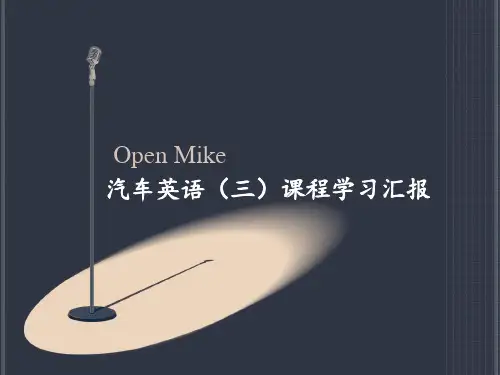
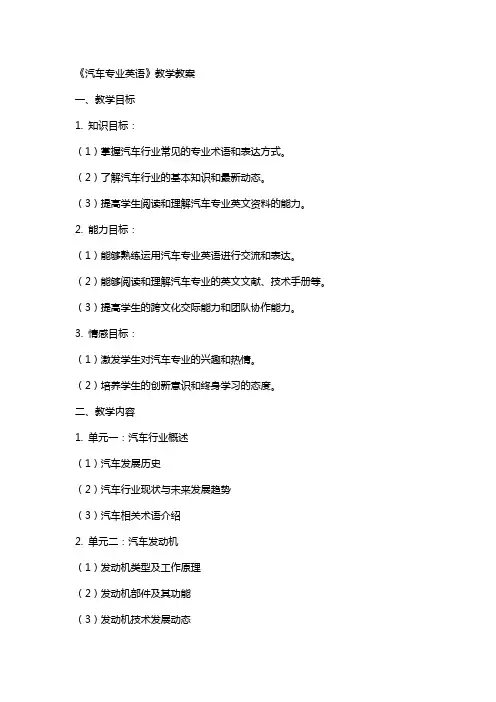
《汽车专业英语》教学教案一、教学目标1. 知识目标:(1)掌握汽车行业常见的专业术语和表达方式。
(2)了解汽车行业的基本知识和最新动态。
(3)提高学生阅读和理解汽车专业英文资料的能力。
2. 能力目标:(1)能够熟练运用汽车专业英语进行交流和表达。
(2)能够阅读和理解汽车专业的英文文献、技术手册等。
(3)提高学生的跨文化交际能力和团队协作能力。
3. 情感目标:(1)激发学生对汽车专业的兴趣和热情。
(2)培养学生的创新意识和终身学习的态度。
二、教学内容1. 单元一:汽车行业概述(1)汽车发展历史(2)汽车行业现状与未来发展趋势(3)汽车相关术语介绍2. 单元二:汽车发动机(1)发动机类型及工作原理(2)发动机部件及其功能(3)发动机技术发展动态3. 单元三:汽车电器与电子技术(1)汽车电器系统概述(2)汽车电子控制系统(3)新能源汽车电器与电子技术4. 单元四:汽车制动系统(1)制动系统类型及工作原理(2)制动器结构与性能(3)制动系统故障诊断与维修5. 单元五:汽车body and pnt(1)车身结构与材料(2)汽车涂装技术(3)车身修复与涂装工艺三、教学方法1. 讲授法:讲解汽车专业英语的基本知识和术语,阐述重点难点。
2. 案例分析法:分析具体汽车案例,培养学生解决实际问题的能力。
3. 小组讨论法:分组讨论,提高学生的团队协作能力和跨文化交际能力。
4. 情景模拟法:模拟汽车行业工作场景,进行角色扮演,提高学生的实际操作能力。
四、教学评价1. 平时成绩:课堂参与度、作业完成情况、小组讨论表现等。
2. 期中测试:汽车专业英语知识测试,检验学生学习效果。
4. 综合评价:结合学生课堂表现、测试成绩和论文质量,进行全面评价。
五、教学资源1. 教材:《汽车专业英语》教材及相关辅助材料。
2. 多媒体教学设备:投影仪、计算机、网络等。
3. 实践教学基地:汽车实验室、维修车间等。
4. 参考文献:汽车专业英文文献、技术手册、期刊杂志等。
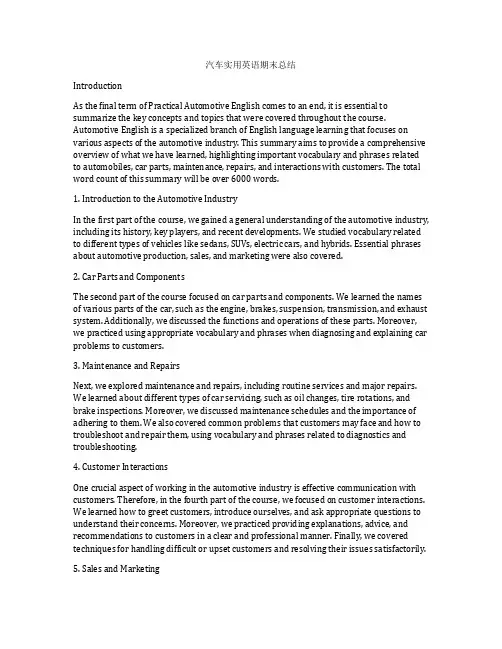
汽车实用英语期末总结IntroductionAs the final term of Practical Automotive English comes to an end, it is essential to summarize the key concepts and topics that were covered throughout the course. Automotive English is a specialized branch of English language learning that focuses on various aspects of the automotive industry. This summary aims to provide a comprehensive overview of what we have learned, highlighting important vocabulary and phrases related to automobiles, car parts, maintenance, repairs, and interactions with customers. The total word count of this summary will be over 6000 words.1. Introduction to the Automotive IndustryIn the first part of the course, we gained a general understanding of the automotive industry, including its history, key players, and recent developments. We studied vocabulary related to different types of vehicles like sedans, SUVs, electric cars, and hybrids. Essential phrases about automotive production, sales, and marketing were also covered.2. Car Parts and ComponentsThe second part of the course focused on car parts and components. We learned the names of various parts of the car, such as the engine, brakes, suspension, transmission, and exhaust system. Additionally, we discussed the functions and operations of these parts. Moreover, we practiced using appropriate vocabulary and phrases when diagnosing and explaining car problems to customers.3. Maintenance and RepairsNext, we explored maintenance and repairs, including routine services and major repairs. We learned about different types of car servicing, such as oil changes, tire rotations, and brake inspections. Moreover, we discussed maintenance schedules and the importance of adhering to them. We also covered common problems that customers may face and how to troubleshoot and repair them, using vocabulary and phrases related to diagnostics and troubleshooting.4. Customer InteractionsOne crucial aspect of working in the automotive industry is effective communication with customers. Therefore, in the fourth part of the course, we focused on customer interactions. We learned how to greet customers, introduce ourselves, and ask appropriate questions to understand their concerns. Moreover, we practiced providing explanations, advice, and recommendations to customers in a clear and professional manner. Finally, we covered techniques for handling difficult or upset customers and resolving their issues satisfactorily.5. Sales and MarketingUnderstanding sales and marketing strategies is essential for professionals in the automotive industry. In the fifth part of the course, we studied vocabulary and phrases related to sales techniques, negotiation skills, and marketing strategies. We learned how to describe car features, highlight benefits, and convince customers to make a purchase. Additionally, we explored advertising techniques and digital marketing in the automotive sector.6. Presentations and ReportsThe final part of the course focused on presentation and report writing skills. We practiced preparing and delivering presentations on various automotive topics, using appropriate visuals and language. We also learned how to write comprehensive reports, including analysis, recommendations, and conclusions. These skills are critical for professionals in the automotive industry to effectively communicate and share information with colleagues and clients.ConclusionIn conclusion, Practical Automotive English has provided us with a strong foundation in automotive-related vocabulary, phrases, and skills. We have gained a comprehensive understanding of the automotive industry and its various aspects, including car parts, maintenance, repairs, customer interactions, sales, and marketing. By mastering these skills, we are now better equipped to communicate effectively with customers, diagnose and troubleshoot car problems, and contribute to the overall success of the automotive industry. This course has undoubtedly enhanced our language skills and prepared us for future career opportunities in the field of automotive English.。

《车辆工程专业英语》课程教学大纲一、课程简介本课程旨在培养车辆工程专业学生掌握基本英语语言知识和专业英语词汇,提高他们的英语听、说、读、写能力,使其能够熟练运用英语进行车辆工程领域的交流和研究。
二、课程目标1. 培养学生的英语听力和口语表达能力,使其能够流利地用英语进行交流和沟通;2. 培养学生的阅读理解能力,使其能够独立阅读和理解车辆工程领域的英文文献;3. 培养学生的写作能力,使其能够书写车辆工程实验报告、论文等各类英文文档;4. 培养学生的翻译能力,使其能够进行中英互译,掌握车辆工程中常用的英文术语。
三、课程内容及安排1. 英语听力与口语表达(32学时)- 练习常用口语表达,如自我介绍、交际用语等;- 听取英文听力材料,并进行听写和听力理解练习;- 进行口语对话训练,如业务咨询、报告汇报等;- 分组进行口语演讲练习,展示车辆工程领域相关主题。
2. 英语阅读与写作(40学时)- 学习车辆工程领域的英文技术文献,培养阅读理解能力;- 阅读并分析车辆工程实验报告范例,学习书写科技论文的结构与方法;- 练习写作车辆工程相关的研究论文、技术报告、项目计划等。
3. 专业英语术语与翻译(28学时)- 学习车辆工程领域的常用英语术语和词汇;- 进行中英互译练习,掌握翻译车辆工程术语的方法和技巧;- 分析车辆工程领域的国际标准和规范,学习其中的英文用语。
4. 文化交流与实践活动(20学时)- 组织学生进行英语角、英语演讲比赛等活动,提高口语表达能力;- 鼓励学生参加车辆工程领域的国际学术交流会议、实习或交流项目,拓宽学生的国际视野。
四、考核方式1. 平时考核(40%):包括课堂表现、作业完成情况、小组讨论等;2. 期中考试(30%):测试学生对课程内容的理解、运用能力;3. 期末考试(30%):综合测试学生在听说读写各个方面的英语能力。
五、参考教材1. 《车辆工程英语教程》- 张明华2. 《汽车工程英语词汇手册》- 张立新3. 《国际标准化汽车工程术语表》- ISO六、其他注意事项1. 学生应积极参与课堂讨论,提高英语口语表达能力;2. 鼓励学生利用多媒体资源和网络资源进行自主学习和扩展;3. 老师将定期进行学习效果的评估和反馈,以帮助学生更好地改进学习方法和提高学习效果。
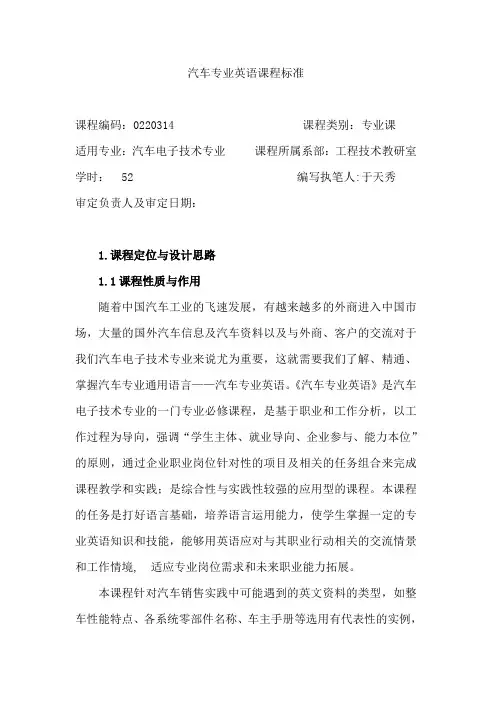
汽车专业英语课程标准课程编码:0220314 课程类别:专业课适用专业:汽车电子技术专业课程所属系部:工程技术教研室学时: 52 编写执笔人:于天秀审定负责人及审定日期:1.课程定位与设计思路1.1课程性质与作用随着中国汽车工业的飞速发展,有越来越多的外商进入中国市场,大量的国外汽车信息及汽车资料以及与外商、客户的交流对于我们汽车电子技术专业来说尤为重要,这就需要我们了解、精通、掌握汽车专业通用语言——汽车专业英语。
《汽车专业英语》是汽车电子技术专业的一门专业必修课程,是基于职业和工作分析,以工作过程为导向,强调“学生主体、就业导向、企业参与、能力本位”的原则,通过企业职业岗位针对性的项目及相关的任务组合来完成课程教学和实践;是综合性与实践性较强的应用型的课程。
本课程的任务是打好语言基础,培养语言运用能力,使学生掌握一定的专业英语知识和技能,能够用英语应对与其职业行动相关的交流情景和工作情境, 适应专业岗位需求和未来职业能力拓展。
本课程针对汽车销售实践中可能遇到的英文资料的类型,如整车性能特点、各系统零部件名称、车主手册等选用有代表性的实例,用英汉对照讲解,并将相关口语交流揉合在实例中,以培养学生汽车专业英文资料的理解能力,并能够用英语进行实际的交流并销售汽车。
本门课程的前导课程有《大学英语》、《汽车机械基础》、《汽车机械识图》、《发动机构造与维修》、《汽车底盘构造与维修》、《汽车电器设备构造与维修》、《发动机总成拆装实训》、《汽车认识实习》、、《汽车营销基础》等课程。
后续课程有《发动机电控技术及检修》、《汽车检测与故障维修实训》、《二手车鉴定与评估》、《汽车检测与维修》等课程。
1.2课程设计思路本课程是汽车电子技术专业的英语课程,对学生所学习的中文汽车结构加以概括、分类,以英文的形式表达出来,用英语介绍了汽车的主要系统构造和工作原理、汽车新结构和新技术方面的汽车电子燃油喷射系统汽车防抱死制动系统、润滑系、冷却系统、安全气囊等。
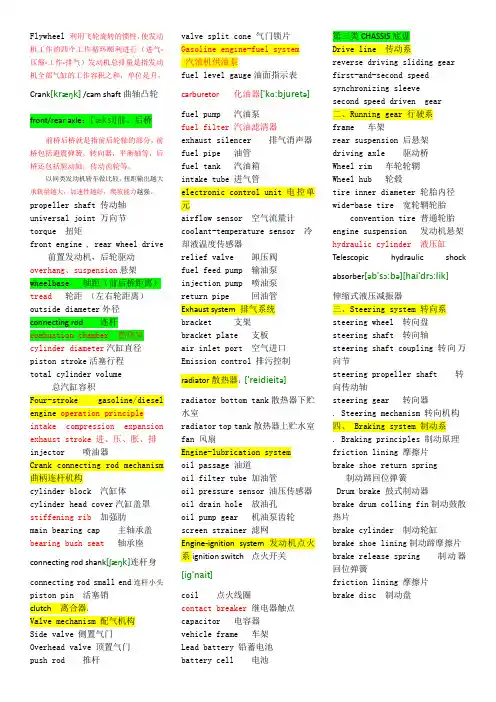
Flywheel 利用飞轮旋转的惯性,使发动机工作的四个工作循环顺利进行(进气-压缩-工作-排气)发动机总排量是指发动机全部气缸的工作容积之和,单位是升。
Crank[kræŋk] /cam shaft曲轴凸轮front/rear axle:['æksl]前、后桥前桥后桥就是指前后轮轴的部分,前桥包括避震弹簧,转向器,平衡轴等,后桥还包括驱动轴,传动齿轮等。
以同类发动机轿车做比较,扭距输出越大承载量越大,加速性越好,爬坡能力越强。
propeller shaft 传动轴universal joint 万向节torque 扭矩front engine , rear wheel drive 前置发动机,后轮驱动overhang、suspension悬架wheelbase 轴距(前后桥距离)tread 轮距(左右轮距离)outside diameter外径connecting rod 连杆combustion chamber 燃烧室cylinder diameter汽缸直径piston stroke活塞行程total cylinder volume总汽缸容积Four-stroke gasoline/diesel engine operation principle intake compression expansion exhaust stroke 进、压、胀、排injector 喷油器Crank connecting rod mechanism 曲柄连杆机构cylinder block 汽缸体cylinder head cover汽缸盖罩stiffening rib加强肋main bearing cap 主轴承盖bearing bush seat轴承座connecting rod shank[ʃæŋk]连杆身connecting rod small end连杆小头piston pin 活塞销clutch 离合器:Valve mechanism 配气机构Side valve 侧置气门Overhead valve 顶置气门push rod 推杆valve split cone 气门锁片Gasoline engine-fuel system汽油机供油泵fuel level gauge油面指示表carburetor 化油器['kɑ:bjuretə]fuel pump 汽油泵fuel filter 汽油滤清器exhaust silencer 排气消声器fuel pipe 油管fuel tank 汽油箱intake tube 进气管electronic control unit 电控单元airflow sensor 空气流量计coolant-temperature sensor 冷却液温度传感器relief valve 卸压阀fuel feed pump 输油泵injection pump 喷油泵return pipe 回油管Exhaust system 排气系统bracket 支架bracket plate 支板air inlet port 空气进口Emission control 排污控制radiator散热器:['reidieitə]radiator bottom tank散热器下贮水室radiator top tank散热器上贮水室fan 风扇Engine-lubrication systemoil passage 油道oil filter tube 加油管oil pressure sensor 油压传感器oil drain hole 放油孔oil pump gear 机油泵齿轮screen strainer 滤网Engine-ignition system发动机点火系ignition switch 点火开关[ig'nait]coil 点火线圈contact breaker继电器触点capacitor 电容器vehicle frame 车架Lead battery 铅蓄电池battery cell 电池第三类CHASSIS底盘Drive line 传动系reverse driving sliding gearfirst-and-second speedsynchronizing sleevesecond speed driven gear二、Running gear 行驶系frame 车架rear suspension 后悬架driving axle 驱动桥Wheel rim 车轮轮辋Wheel hub 轮毂tire inner diameter 轮胎内径wide-base tire 宽轮辋轮胎convention tire 普通轮胎engine suspension 发动机悬架hydraulic cylinder 液压缸Telescopic hydraulic shockabsorber[əb'sɔ:bə][hai'drɔ:lik]伸缩式液压减振器三、Steering system 转向系steering wheel 转向盘steering shaft 转向轴steering shaft coupling 转向万向节steering propeller shaft 转向传动轴steering gear 转向器. Steering mechanism 转向机构四、 Braking system 制动系. Braking principles 制动原理friction lining 摩擦片brake shoe return spring制动蹄回位弹簧Drum brake 鼓式制动器brake drum colling fin制动鼓散热片brake cylinder 制动轮缸brake shoe lining制动蹄摩擦片brake release spring 制动器回位弹簧friction lining 摩擦片brake disc 制动盘。
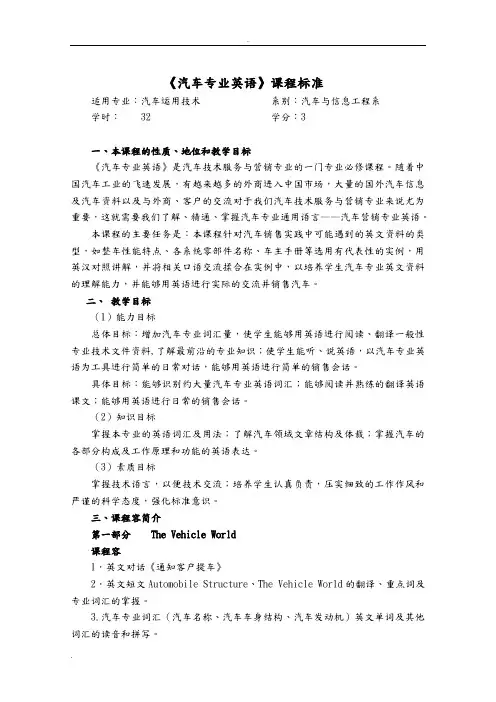
《汽车专业英语》课程标准适用专业:汽车运用技术系别:汽车与信息工程系学时: 32 学分:3一、本课程的性质、地位和教学目标《汽车专业英语》是汽车技术服务与营销专业的一门专业必修课程。
随着中国汽车工业的飞速发展,有越来越多的外商进入中国市场,大量的国外汽车信息及汽车资料以及与外商、客户的交流对于我们汽车技术服务与营销专业来说尤为重要,这就需要我们了解、精通、掌握汽车专业通用语言——汽车营销专业英语。
本课程的主要任务是:本课程针对汽车销售实践中可能遇到的英文资料的类型,如整车性能特点、各系统零部件名称、车主手册等选用有代表性的实例,用英汉对照讲解,并将相关口语交流揉合在实例中,以培养学生汽车专业英文资料的理解能力,并能够用英语进行实际的交流并销售汽车。
二、教学目标(1)能力目标总体目标:增加汽车专业词汇量,使学生能够用英语进行阅读、翻译一般性专业技术文件资料,了解最前沿的专业知识;使学生能听、说英语,以汽车专业英语为工具进行简单的日常对话,能够用英语进行简单的销售会话。
具体目标:能够识别约大量汽车专业英语词汇;能够阅读并熟练的翻译英语课文;能够用英语进行日常的销售会话。
(2)知识目标掌握本专业的英语词汇及用法;了解汽车领域文章结构及体裁;掌握汽车的各部分构成及工作原理和功能的英语表达。
(3)素质目标掌握技术语言,以便技术交流;培养学生认真负责,压实细致的工作作风和严谨的科学态度,强化标准意识。
三、课程容简介第一部分 The Vehicle World课程容1.英文对话《通知客户提车》2.英文短文Automobile Structure、The Vehicle World的翻译、重点词及专业词汇的掌握。
3.汽车专业词汇(汽车名称、汽车车身结构、汽车发动机)英文单词及其他词汇的读音和拼写。
工作任务、能力目标1、能够理解课文英文对话《通知客户提车》的意思和对话技巧,并且能进行简单模仿对话。
2、翻译英文短文Automobile Structure,掌握短文重点单词。
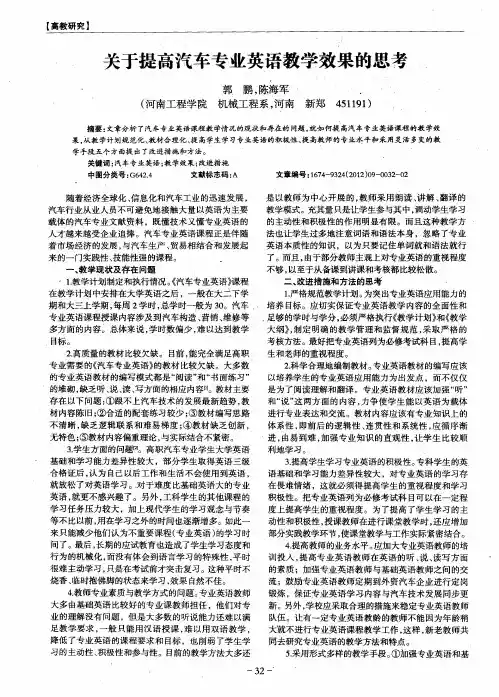
《汽车专业英语》教学教案一、教学目标1. 知识目标:(1)掌握汽车行业常见专业词汇和表达方式;(2)了解汽车行业的基本概念、原理和技术;(3)熟练阅读和理解汽车专业英语文献。
2. 能力目标:(1)能够运用所学的专业词汇和表达方式进行日常交流;(2)具备阅读和翻译汽车专业英语文献的能力;3. 情感目标:激发学生对汽车专业的兴趣,提高学生学习专业英语的积极性。
二、教学内容1. 汽车基本概念:汽车的历史、类型和组成;2. 汽车发动机:内燃机、电动机和工作原理;3. 汽车传动系统:手动变速器、自动变速器和CVT;4. 汽车制动系统:液压制动、电子制动和ABS;5. 汽车电子技术:传感器、控制单元和车载网络。
三、教学方法1. 讲授法:讲解汽车基本概念、原理和技术;2. 案例分析法:分析典型汽车部件和工作原理;3. 小组讨论法:探讨汽车行业的发展趋势和问题;4. 实践操作法:阅读和翻译汽车专业英语文献。
四、教学步骤1. 导入:介绍汽车行业的发展现状和趋势;2. 讲解:讲解汽车基本概念、原理和技术;3. 案例分析:分析典型汽车部件和工作原理;4. 小组讨论:探讨汽车行业的发展趋势和问题;5. 实践操作:阅读和翻译汽车专业英语文献。
五、教学评价1. 平时成绩:考察学生的出勤、发言和作业完成情况;2. 期中考试:测试学生的专业词汇、阅读理解和写作能力;3. 期末考试:考察学生的综合运用能力和知识掌握程度。
六、教学资源1. 教材:《汽车专业英语》教材及相关辅助资料;2. 课件:制作精美的课件,辅助讲解和展示;3. 视频资料:汽车工作原理和部件动画演示;4. 网络资源:查阅相关汽车专业英语文献和资讯。
七、教学环境1. 教室:配备投影仪、电脑、白板等教学设备;2. 实验室:汽车发动机、变速器等实物展示;3. 网络环境:校园网或无线网络,便于查阅资料。
八、教学进度安排1. 课时:本课程共计32课时,每周2课时;2. 教学安排:按照教学大纲和教案进行授课;3. 课后作业:布置相关阅读材料和练习题,巩固所学知识。
汽车检测与维修技术专业V ehicle Inspection and Maintenance Technology专业培养计划英文翻译人才培养方案专业代码:580402 专业:汽车检测与维修技术一、培养目标本专业培养德、智、体、美全面发展,具有良好的职业道德、熟练的职业技能,可持续发展的基础能力,掌握“必需、够用”的专业知识,面向汽车维修、汽车检测、汽车使用、汽车制造等生产一线,从事汽车制造、使用、维修、检测和管理等工作的高端技能型专门人才。
严格推行多证书制度,学生在毕业前,本专业毕业生至少获取汽车维修工中级证书、汽车维修电工中级证书、汽车驾驶证书其中的至少一种。
所开设的汽车电控系统检修、汽车行驶转向制动系统检修、汽车电气系统检修等课程为英国轻型车辆维修和保养三级技工证书课程,将提高学生在国内和国际相关行业企业的就业能力。
Ⅰ. Cultivation GoalThis specialty provides well-developed & skillful talents who have good professional ethics, competent skills, and master enough theoretical expertise, and own the ability for actual automobile maintenance, automobile inspection, automobile application, automobile manufacturing etc.This specialty strictly implements the multi-certificate system. The graduates should get at least one of the following certificates before graduation: middle-rank certificate for automotive maintenance, middle-rank electrician certificate for automotive maintenance, car-driving license. Besides, one must obtain an exquisite skills certificate in vehicle inspection and maintenance specialty of the Y ellow River Conservancy Technical Institute.Students of this specialty will learn the courses of UK Light V ehicle Repair and Maintenance Level Three Certificate including Inspection & Maintenance of Automotive Electrical-control System, Inspection & Maintenance of Automobile Running/Steering and Braking System, Inspection & Maintenance of Automotive Electric System, which willimprove the employability of students in domestic and foreign enterprises.二、基本规格1.掌握一定的自然科学、人文和社会科学基础知识,辩证唯物主义的思想方法。
关于提高《汽车专业英语》教学质量的探讨摘要:本文结合高职院校汽车专业《汽车专业英语》课程的教学实践,根据汽车专业英语的特点,就如何提高学生专业英语水平,提高教学质量,如何改进教学方法环节进行了分析和探讨。
同时提出了一些有针对性的、可行性的教学方法。
关键词:汽车专业英语提高教学质量教学方法0 引言随着经济全球化和信息全球化的快速发展,我国进口汽车及汽车零部件的数量不断增加,而这些进口汽车的零部件和技术绝大部分都是用英文标示的,针对汽车制造过程中各个工种的不同,需要不同程度的英语知识,由此可见,结合实际和市场需求,对于高校汽车专业的学生而言需要掌握大量英语汽车文献资料,具有一定的汽车专业英语技能。
汽车专业英语是高职高专汽车类专业学生必要的一门专业课,为了适应汽车工业的迅猛发展,充分体现高职教育培养高技术实用型人才的特色,应当以市场为导向,本着学以致用的原则,在教学内容和教学方法上,不断思考和改进,通过教学使学生掌握一定数量的汽车专业英语词汇,突出对阅读和翻译能力的培养,读懂先进的汽车零部件英文使用说明书,能初步阅读和理解专业所需的英文资料,能进行基本的英语口语交流。
为使英语程度不同的学生都有较大的收获,文中对如何搞好汽车专业英语教学进行了探讨。
1 课程开设的必要性教育部《高职高专教育英语课程教学基本要求》明确指出:在完成《基本要求》规定的教学任务后,应结合专业学习,开设专业英语课,这既可保证学生在校期间英语学习的连续性,又可使学生所学英语得到实际应用。
专业英语是基础英语的后续课程,是培养学生掌握必需的、实用的专业英语语言知识和技能。
另外,我国汽车行业发展迅速,很多汽车制造企业购置的进口高精度的先进的发动机及其附属设备,包括硬件和软件,作为安装维修这些设备的技术人员有必要从外文说明书中全面了解设备的性能指标、使用方法、掌握准确的资料。
特别是中国加入wto后,在汽车领域与国际合作的项目日益增多,合作的领域也越来越广泛,所以就越来越需要更多的既精通专业技术,又懂英语的专业人才,因此开设汽车专业英语是非常必要的。
汽车专业英语学生期末总结The semester began with a strong foundation in fundamental automotive engineering concepts. In the first few weeks, we covered topics such as vehicle dynamics, thermodynamics, and powertrain systems. These courses provided a solid understanding of the principles behind vehicle design and operation. We learned about suspension systems, engine performance, and how different components work together to create an efficient and reliable vehicle.One of the highlights of the semester was our participation in several hands-on projects. Working in teams, we were given the opportunity to apply the knowledge gained in the classroom to real-world scenarios. One particular project involved designing and building a mini Formula-style race car. This project required us to select appropriate materials, optimize vehicle performance, and work within a limited budget. Through this experience, I not only learned about the practical aspects of engineering but also enhanced my skills in teamwork, communication, and problem-solving.In addition to the technical courses, we also had the chance to study automotive business and management. These courses introduced us to the challenges and complexities of the automotive industry. We learned about marketing strategies, supply chain management, and industry regulations. These insights will be crucial in my future career as they provide a broader perspective on how the automotive industry operates as a whole.Throughout the semester, I also had the opportunity to attend various industry conferences and workshops. These events allowed me to network with professionals in the field and gain insights into current trends and innovations. One conference that stood out to me was the "Future of Electric Vehicles" symposium. I learned about the latest advancements in battery technology, electric vehicle infrastructure, and the impact of electric vehicles on the environment. This not only expanded my knowledge but also inspired me to consider specializing in electric vehicle design in the future.As the semester comes to a close, I have set certain goals for myself in the coming months. First and foremost, I plan to continue strengthening my technical skills by exploring advanced courses in automotive engineering. I am particularly interested in studying alternative fuels, autonomous vehicles, and vehicle safety systems. By staying up to date with the latest technologies, I can ensure that I am prepared for the future challenges of the industry.Additionally, I aim to gain practical experience through internships or co-op opportunities. By working in a professional setting, I will be able to apply the knowledge and skills gained in the classroom to real-world situations. This will not only enhance my understanding of the industry but also provide valuable networking opportunities and potentially open doors for future employment.Finally, I plan to actively engage in research within the automotive field. By contributing to ongoing projects or conducting my research, I can deepen my understanding of specific automotive topics and potentially make valuable contributions to the industry. This will require a significant amount of independent study and collaboration with faculty members, but I believe it will be a rewarding and worthwhile endeavor.In conclusion, this semester has been a transformative journey for me as an automotive engineering student. I have gained a solid foundation in automotive engineering principles, participated in hands-on projects, learned about the business aspects of the industry, and networked with professionals. Looking ahead, I am excited to continue my education, gain practical experience, and contribute to the advancement of the automotive field. I am confident that with determination and perseverance, I will achieve my goals and make a positive impact in the ever-evolving world of automotive engineering.。
汽车专业英语的学习之旅:跨越语言障碍,探索汽车技术的无限可能In the realm of automotive engineering, the language barrier can often pose a significant challenge, especially when dealing with cutting-edge technologies and innovative concepts. This is where the importance of automotiveEnglish comes into play. My journey in learning automotive English has been an eye-opening experience, allowing me to delve deeper into the intricacies of the automotiveindustry and its constantly evolving landscape.Automotive English is not just about mastering the vocabulary and grammar; it's about understanding thenuances of the industry and its global context. It's about comprehending technical documents, specifications, and manuals written in a language that is both precise and concise. It's about being able to communicate effectivelywith colleagues, suppliers, and customers, regardless oftheir nationality or linguistic background.Learning automotive English has enabled me to gain a deeper understanding of the latest advancements in the automotive industry. I have been able to familiarize myselfwith terms like autonomous driving, electric vehicles, and connected cars, which are rapidly shaping the future of transportation. This knowledge has not only broadened my perspective but has also equipped me with the tools necessary to stay ahead of the curve in this rapidly evolving field.Moreover, automotive English has provided me with a window to the global automotive industry. By understanding the common language of the industry, I have been able to explore opportunities beyond my immediate surroundings. This has opened up a world of possibilities, allowing me to collaborate with experts from around the world and learn from their experiences and perspectives.The challenges of learning automotive English have been numerous, but the rewards have been equally enriching. The process of decoding technical jargon and understanding complex concepts has been both challenging and rewarding.It has been a constant learning process, one that has required dedication, perseverance, and a willingness to embrace new ideas and concepts.In conclusion, my journey in learning automotiveEnglish has been a transformative experience. It has notonly expanded my professional horizons but has also enhanced my ability to communicate and collaborateeffectively in an increasingly globalized automotive industry. As I continue to explore the depths of this fascinating field, I am excited about the opportunities and challenges that lie ahead.**汽车专业英语的学习之旅:跨越语言障碍,探索汽车技术的无限可能**在汽车工程领域,语言障碍常常成为一个巨大的挑战,尤其是在处理尖端技术和创新概念时。
《汽车专业英语》课程总结
课程名称:汽车专业英语
授课对象:14汽修高级工1班,3班,4班,5班,14汽修技师班
使用教材:中国劳动(社会保障)出版社出版的《汽车专业英语》第二版
一、教材情况
讲授单元:14汽修高级工1班,3班,4班,14汽修技师班
授课单元为1,2, 3,4,5,6,7,8 ,10,11,13,15,16,
18,和19单元。
4课时/周
14汽修高级工5班
授课单元为1,2, 3,4,5,6,7,8 和10单元。
2课时/周二、备课方面
由于教授的是高级工学生,我在备课方面尤其要有针对性,要考虑到好学生的需求,但同时也要顾及到英语基础较差的学生,所以在一堂课中所讲的东西要涵盖不同层次。
三、上课方面
1.能较好的贯彻课堂教学中“以学生为中心”的原则。
课文内容的讲解中,我经常让学生尝试翻译课文中的句子或段落,讲解练习的时候,每道问题我都让学生说出他们的答案,并给与解释,避免我作为老师“一堂言”的现象。
在听说课上,我给学生充分的机会练习口语,提高他们对英语的兴趣。
2. 学生在回答问题或朗读单词和课文时,有时候会出现错误,这时候,我
能运用启发式的思维方法引导学生查出自己出错的地方,进而得到正确的答案。
3. 上课的板书我坚持做到规范,字迹工整清晰。
因为板书是一个教师的门
面,它的好坏会影响学生对教师的印象,所以我特别注重自己的板书。
四、作业方面
我坚持每周都给学生留作业,因为作业是反映学生对上课老师所讲内容的接受程度的衡量标准。
学生的作业通常包括:单词背诵,句子和段落翻译等形式。
对于学生的作业我都认真批改,给学生指出错误。
五、学生方面
总的来说这几个高级工班的学生都还算认真,除了个别几个学生外,其他同学基本上能完成教师布置的作业,上课时给与教师积极的配合,从而形成良好的课堂气氛。
对于老师讲的知识点也有较好的互动和反馈。
但是14汽修技师班学生基础较为薄弱,大部分男生完全听不懂老师在讲什么,针对这个问题,我让学生在课下多做练习以及预习,以逐渐提高他们的基础。
出勤情况:这几个班的学生总体来说出勤比较好,除了14汽修高级工4班和14汽修技师班的个别同学以外。
六、汽车专业英语这门课为考查课,卷子内容紧扣课上所学,70%为书上内容,
30%为课外的阅读理解题,可以充分体现学生在课上听讲和对基础知识掌握的扎实程度。